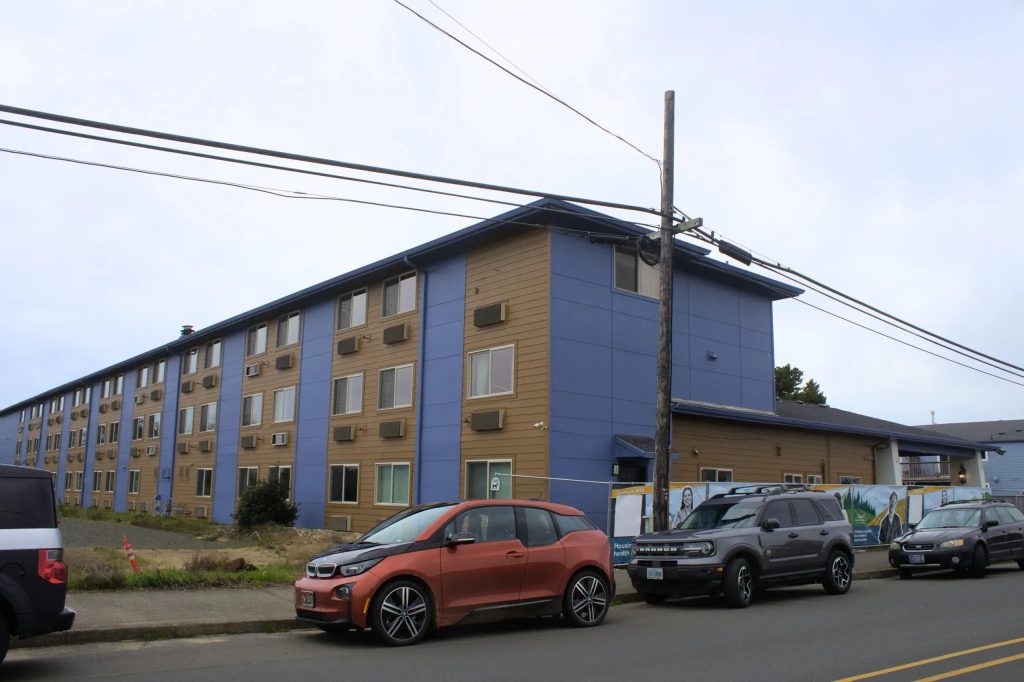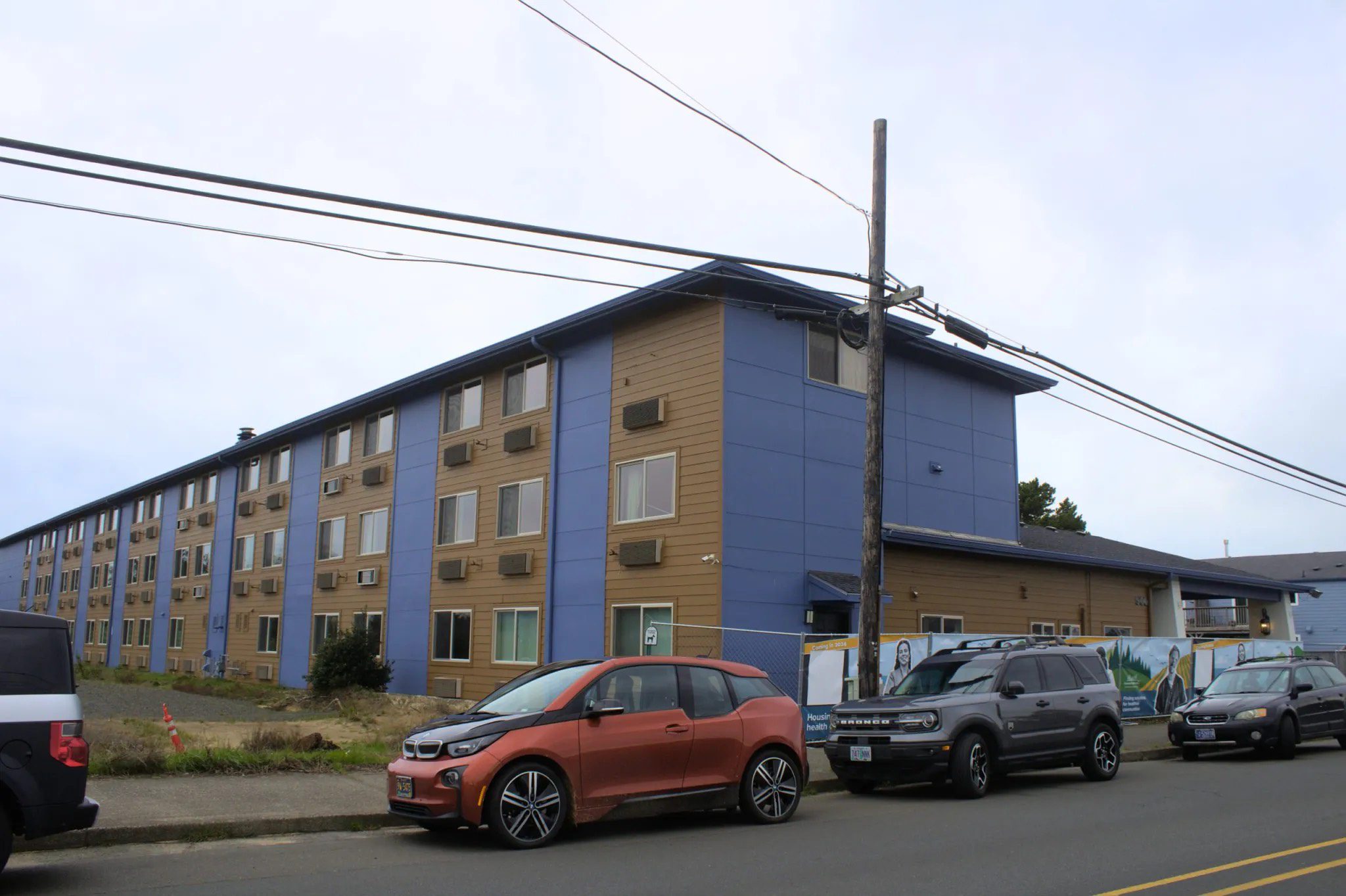
The exterior of the former Red Lion Inn in Seaside, Oregon. Photo by Claire Carlson
Cloudy skies loomed over the small coastal town of Seaside, Oregon, on a November morning late last year, but the rain stayed away as a group of residents, health care workers, and city officials gathered outside of what had been, up until a few months before, a Red Lion Inn.
The group was gathered to celebrate the former hotel’s new role as an affordable housing development for people struggling with chronic homelessness and as transitional housing for the local hospital’s workforce.
While Seaside is one of several small towns in northwest Oregon’s Clatsop County that is known for its bucolic tourism industry, the region is struggling with a lesser-known but dire housing shortage where one out of every 40 individuals is homeless. This is the highest per capita homelessness rate of any county in the state of Oregon.
There are plenty of theories why this coastal county’s housing problem has gotten so bad, but officials say it boils down to one key issue: a lack of money for rural affordable housing development.
“We have urban-scale problems in a rural area, but we only have rural-level resources to address it,” said Elissa Gertler in a Daily Yonder interview. Gertler was appointed housing manager for Clatsop County earlier this year. Her position is newly made to tackle the region’s housing issues.
Gertler says these “urban-scale problems” come in the form of tourism, which at its summer peak can nearly double the population of Clatsop County from 41,000 year-round to 80,000. Vacation homes dot the shoreline, and finding an affordable long-term rental is tough, locals say. The median home sale price in Clatsop County in October of 2023 was $539,000, according to data from the real estate company Redfin.
‘We have urban-scale problems in a rural area, but we only have rural-level resources to address it.’
Oregon also has some of the strictest building regulations in the country, which makes any new development difficult. Building on the coast is even more challenging because of tsunami zones and national forest land that limit where new construction can occur.
This is where the Red Lion Inn comes into play. The building, purchased earlier this year by the state’s health care plan CareOregon that serves Oregonians on Medicaid, doesn’t face the construction challenges that other affordable housing projects contend with on the coast because it’s already built. The Red Lion Inn just needs renovation, which began in early November when the project’s leaders and county officials gathered at a ceremonial “groundbreaking” event.

CareOregon employees and Clatsop County officials pose with sledgehammers and hard hats in the lobby of what used to be the Red Lion Inn. Photo by Claire Carlson
Once finished, 55 rooms will be available for rent: 37 for workforce housing and 18 for low-income housing. The building should be move-in ready by late spring of 2024, according to the project’s leaders. Rent hasn’t been determined yet, but the tentative number named at the groundbreaking event for workforce housing was $1,100 per month, utilities included. This number could change before next spring, project leaders emphasized.
The Red Lion Inn housing project is one glimmer of hope in a rural area that’s been struggling to gain access to resources to address their housing needs.
In March of 2023, Oregon Gov. Tina Kotek signed into law a $200 million spending package to address the state’s homelessness crisis. The state’s most populous counties—Clackamas, Multnomah, and Washington—were granted between $4,000 and $6,000 for every unsheltered person. Even though Clatsop County has the highest rate of homelessness in the state, it received just $1,500 per unsheltered person.
Clatsop officials petitioned the state for more money and in September were given $3.8 million, more than any other rural Oregon county. About one-third of this money went to Clatsop Community Action to convert the Columbia Inn in Astoria to a homeless shelter, one-third to LIFEBoat Services to pay for shelter beds, and the last third to fund a multi-agency coordination group for planning between local and state housing services.
‘We are dependent on our partnership with the state in a way that I think the large urban areas don’t have to be [because] they have more local tools.’
But the struggle to get this money highlights an issue all too familiar to rural communities: inequitable access to state and federal grants. Learning about what grants are available is the first hurdle that rural counties must overcome, then devoting the time and money to apply for them is its own struggle. In small counties with limited resources to devote to this process, it can be extremely difficult to compete with metro areas for the same money.
Gertler, the Clatsop County housing manager, said Oregon Housing and Community Services has been working with Clatsop County to understand this issue and remove barriers to the grant application process, but nothing has changed yet, even though smaller counties depend on state money in a way cities don’t have to.
[RELATED ARTICLE: Preparing Underinvested Communities for New Funding]
“We are dependent on our partnership with the state in a way that I think the large urban areas don’t have to be [because] they have more local tools,” Gertler said. These tools include nonprofit, faith-based, and other local organizations that organize around homelessness in cities. These organizations exist in Clatsop County, too, but not to the same extent as in Oregon’s metro areas.
One resource that does operate in Clatsop County is Helping Hands, a nonprofit organization that provides low-barrier emergency shelters and long-term recovery services to people struggling with homelessness, mental health issues, or addiction. They provide more than 350 beds to unsheltered people in five Oregon counties, rural and urban. But they’ve struggled to get state funds, too.
“[The state] makes all the [funding] decisions based off of the people who are on fire, the people who need [help] the most,” said Alan Evans, president of Helping Hands, in a Daily Yonder interview. Evans said they’ve been left out of grant funding from the state because they prioritize a long-term recovery model versus short-term mental health and addiction solutions. Helping Hands relies primarily on donations and a limited number of grants to operate.
“We’re a community-based organization that believes investing in people to be sustainable in a community is the number one thing,” Evans said. “To find out that the funding streams available don’t support that, [that points to] the deeper issue of why we’re having this [housing] problem.”
The Red Lion Inn project is an attempt to solve part of this problem, focusing mainly on housing for local health care providers and some housing for low-income people.

Pamela Cooper, Providence Hospital’s director of finance, at the Nov. 9 groundbreaking event at the former Red Lion Inn. Photo by Claire Carlson
The workforce housing will provide short-term, motel-style rooms for health care workers moving to Clatsop County to work at Providence Hospital, located in Seaside. Like many rural communities, Clatsop County faces a dearth of health care providers, especially for specialty care like rheumatologists, gastroenterologists, and psychiatrists. The hospital recently hired its first pediatrician, according to Pamela Cooper, director of finance at Providence Hospital. She is closely involved in the hospital’s hiring and onboarding process for new employees, and has taken on a role her colleagues call the “landlord wrangler.”
“When [new employees] take on a job and they move to the area, they usually don’t have the money right away to buy a home,” Cooper said in a Daily Yonder interview. “And they don’t have the income history if they’re right out of school, or sometimes they have to sell another home, or maybe they don’t know exactly where they want to purchase. And so they need what we call transitional time to be in a rental.”

CareOregon CEO Eric Hunter reveals the new logo of the affordable housing development that will take the place of the Red Lion Inn, to be called Hawk’s Eye Apartments. Photo by Claire Carlson
These rentals are extremely hard to find on the Oregon coast, which is why Cooper’s role in establishing agreements with local landlords to rent to her employees is so essential. The Red Lion conversion project promises to add a significant number of rental properties available to the pool of options Cooper has already created, which should help improve the region’s access to quality health care.
As for the Red Lion Inn project’s 18 low-income housing rentals, they promise to provide stable housing to people struggling with mental health and addiction. On-site management from Clatsop Behavioral Health will be made available for the supportive housing tenants.
While the project won’t solve Clatsop County’s homelessness crisis, community members say it’s a step in the right direction, and addresses the adjacent issue of rural healthcare access.
“I think [the Red Lion project] is something that’s direly needed,” Evans from Helping Hands said. But without continued support for every level of Clatsop County’s housing crisis—from homelessness resources to providing more housing to middle-class residents—the area will continue to suffer, according to Evans.
“It is a small step in solving the problem, but it is going to get perpetually worse if we don’t support all the programs that provide [housing] services in the community,” he said.






Comments